Published
on 18
Mar 2020
|
All rights reserved.
|
|
|
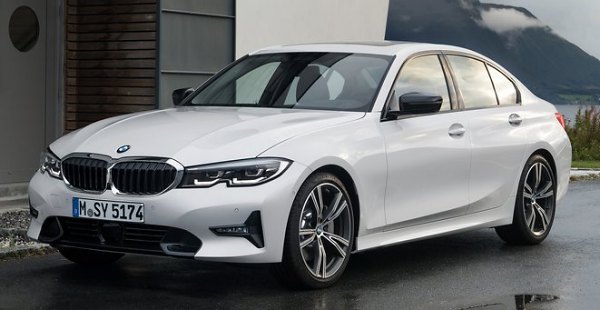
|
|
BMW
is determined to make the 3-Series sporty once again...
|
|
The junior executive car
segment has progressed a lot over the past decade. New contenders like
Jaguar XE, Alfa Romeo Giulia, Kia Stinger and (Hyundai) Genesis G70
entered the competition, while traditional players like Mercedes
C-class, Audi A4 and Volvo S60/V60 have never stopped improving. There
are also some unconventional entrants like the coupe-style Audi A5
Sportback,
Peugeot 508, Volkswagen Arteon and even the full-electric Tesla Model
3. All of them are ready to challenge BMW 3-Series, which dominated the
class it pioneered over the past 45 years. Does BMW feel the pressure?
Yes, undoubtedly a lot. When the outgoing 3-Series, codenamed F30,
debuted 8 years ago, it was still praised for the most versatile car in
the class – fast, fabulous to drive yet efficient, refined, comfortable
and easy to live with. However, when the battles unfolded, it lost the
handling crown to Alfa Romeo and Jaguar (some said even Cadillac,
though I think neither ATS nor CTS were its direct rivals), refinement
crown to Mercedes and Audi and efficiency crown to Tesla (of course).
More problematic, the Korean duo offers arguably more driving fun for
less money. Still, we kept it at the top of its class, not because it
excelled in any particular area, but it was relatively rounded, with no
particular weakness except
the lack of steering feel. Apparently, the F30 has lost its limelight.
BMW has to think hard how to revive its mojo.
Is the new G20 the right answer? Before inspecting its various aspects,
let’s make it clear: BMW is determined to make it sporty once again.
And I mean Sporty! Perhaps best demonstrated this is the fitment of
“lift-related” dampers for the standard suspension as well as M Sport
suspension. The outgoing F30 needed the optional adaptive dampers
desperately to handle and ride well, whereas its standard suspension
was deemed to be too soft and the M Sport suspension too stiff. To
address this problem, BMW developed the lift-related dampers. It is a
cost-effective passive damper, but beside the main piston there is an
additional, smaller auxiliary piston at the top or the bottom end. When
the damper compresses or rebounds, the auxiliary piston approaches the
narrowed section of the damper body, increasing resistance. This means,
the more compression or rebound, the stiffer the damping becomes. It is
just like the hydraulic bump stops used on some Citroens, Peugeots,
Renaults or Hondas, but it works across a wider range of suspension
travel instead of the top end. On the G20, the suspension setup is
stiffer than its predecessor, especially on the standard suspension.
However, as the lift-related dampers are designed to limit rebound up
front and compression at the rear, the car should have better control
over its body motions, hence the feeling of more composure.
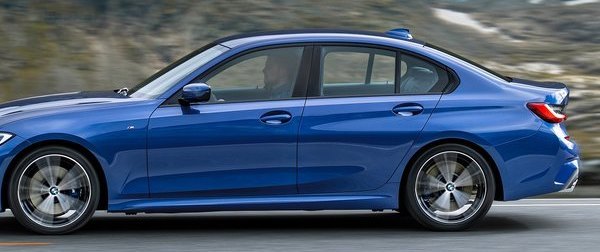
|
|
Lift-related
dampers lift the game as well.
|
|
On the first sight, the new car doesn't seem to change much, although
it does look a bit larger, closer to the territory of 5-Series. Its
proportion remains, but get closer and you will see some significant
changes. For example, the long-standing "Hofmiester kink" at the
C-pillar gets angular, which takes some getting used to. The headlights
and double-kidney grille are also more angular, and the latter is now
made in a single piece of metal. The long bonnet is more contoured. At
the rear, the 3D L-shape taillights look much different from the past,
though not necessarily more stylish.
Just as visible from outside, the G20 is 76mm longer than the F30. 41mm
of which goes to the wheelbase, while most of the rest to the front
overhang to deal with crash protection demand. The body width is only
16mm wider, but it looks far more than that because the front end is no
longer tapered inward. This means the front bumper gets much wider,
enabling the front track to be widened by 43mm, while rear track is
21mm wider. Despite the larger exterior dimensions, the interior is
just marginally larger. Having said that, you should remember that the
old car was never short of space for four adults.
More sheet metal does not increase weight. On the contrary, the new car
is said to be up to 55kg lighter than before, although a 330i is only
25kg lighter, while 320d is actually 5kg heavier. Its body-in-white is
about 20kg lighter. Its engine subframe and front spring struts are
both converted to aluminum, saving 7.5kg. The bonnet and front fenders
are also made of aluminum now, saving another 15kg. Meanwhile, body
rigidity is lifted by 25 percent, or 50 percent at some crucial areas
like suspension mounting points. These improvements should aid handling
and ride, capable of withstanding the stiffer suspension. Moreover, the
new car cuts noise by adopting laminated windscreen.
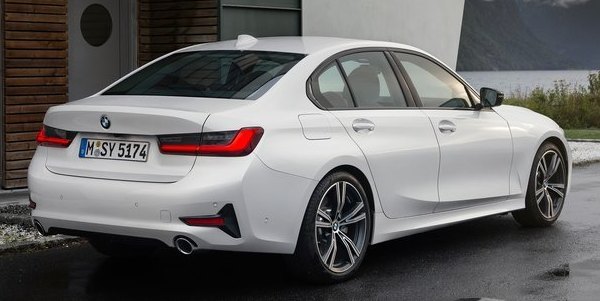
|
|
The
body is larger yet stronger and lighter. Center of gravity is dropped
by 10mm.
|
|
Aerodynamics is also considerably improved. Base models like 320d now
achieve a Cd of merely 0.23, down from 0.26. This matches arch-rival
Audi A4 and beats Mercedes C-class (0.24). Contributing to the
improvement include underbody sealing, side air curtains and active
shutter grilles (now include the double-kidney).
Although the G20 is built on the modular platform called CLAR
(clustered Architecture), which is shared with all the firm’s models
with longitudinal powertrain, it employs simpler strut suspensions up
front, while keeping a multi-link setup at the rear. Adaptive dampers
remain an option – and highly recommended for optimum ride and
handling, although the standard lift-related dampers are no slouch. M
Sport suspension sits 10mm lower while using 20 percent stiffer springs
and stiffer anti-roll bars. Caster angle of the front wheels has been
increased to improve self-centering and steering feel. The 3-Series
keeps its trademark 50:50 balance - more precisely, 51.7:48.3 for 330i
or 52.6:47.4 for M340i xDrive. Center of gravity is dropped by 10mm
compared with the last generation.
Inside, the new car sees a complete change of interior design theme,
more in line with the new 8-Series. It is a lot more modern, cleaner,
more sophisticated and much higher in material quality. The 10.3-inch
touch screen is better integrated with the center console but you can
still use the iDrive rotary knob to control. Additionally, there is a
voice recognition system that mimics Mercedes’ MBUX by using “Hey BMW”
to start your command, although it doesn’t always understand. As you
would
expect, the BMW’s driver seat is supportive, the driving position is
perfect and highly adjustable. Ergonomics are good thanks to the
driver-oriented center console and the well-designed i-Drive operating
system. On the downside, the 12.3-inch instrument display is not as
good as Audi’s Virtual Cockpit. It puts the speedometer and rev counter
at the sides such that the latter turns counterclockwise, while other
information are located arbitrarily. Such a layout places style above
readability. The rear bench is easily more spacious that most rivals,
so 6-footers will find good head and leg room behind another 6-footer.
The boot is also very large at 480 liters.
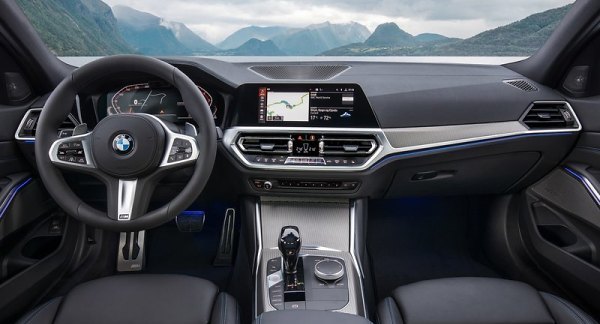
|
|
Interior
styling and build quality are vastly improved.
|
|
Although most engines are carried over or lightly updated, the G20
still offers the strongest engine range in the
class. 3 of them are worth particular attention:
B48 2-liter turbo (320i and 330i): it produces 184hp and 221lbft on
320i, or 258hp and 295lbft on 330i – the latter is an increase of 6hp
and 37lbft over its predecessor. The 330i engine is still the benchmark
of the class. It is not as powerful as Alfa Romeo’s 2.0 Multiair turbo,
but it pulls strongly from the low end and keeps its power across a
wide band, achieving 0-60 mph in an outstanding 5.5 seconds. It is also
quite smooth for a four-cylinder, delivers the highest economy figure
among
rivals. The only downside is lacking an inspiring sound.
B47 2-liter turbo diesel (318d and 320d): BMW’s four-cylinder diesel is
neither the smoothest nor the quietest, but you cannot argue about
their power and efficiency. The 318d produces 150hp and 236lbft with a
single turbo. The 320d version has upgraded to a sequential twin-turbo
setup and 2700 bar injection. Its output remains unchanged at 190hp and
295lbft, but it responds more keenly at low revs than its single-turbo
predecessor, and it revs willingly to the 5000 rpm redline. This must
be a good news to European customers, as 320d is the most popular model
there.
B58 3-liter turbo (M340i): the new range-topper, excluding M3, is now
called M340i instead of 340i. Coming together with the M Performance
badge is increased power and torque, now 374hp and 369lbft instead of
326hp and 332lbft. American version is even stronger at 382hp (or 387hp
DIN) as it is free of particulate filter. As before, BMW’s straight-six
motor is creamy smooth, responsive and produces nice sound. It is more
willing to rev than the four-cylinder, and performance is another
level. With xDrive fitted as standard, European model reaches 60 mph in
merely 4.2 seconds, strong enough to beat a V8-powered E90 M3.
Rear-wheel drive is available to only America, which does the same
sprint in 4.4 seconds.
All 3-Series models but the base diesel employ the excellent ZF 8-speed
automatic as their only transmission. It might be sad that driver
engagement is sacrificed, but you cannot argue that the ZF unit is
incredible: smooth, responsive, accurate and faster than manual. Many
other manufacturers employ the same unit, but no one tunes it as good
as BMW.
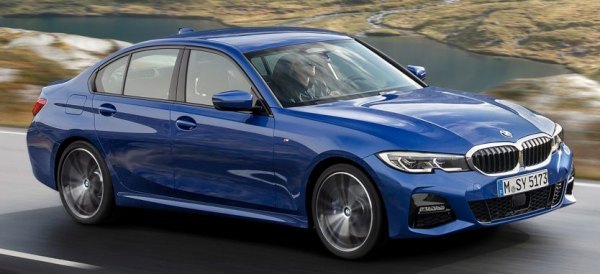 |
|
Alfa
Giulia might be still preferred by the purists, but the BMW has closed
the gap in driver engagement and overwhelms it in so many other areas.
|
|
On the road, the first thing you notice is that the new 3-Series rides
with extra firmness. To call this the sportiest junior executive car is
not overstated. On standard suspension, it is already firmer than
rivals. Passive M Sport suspension is sportier still, so you won’t
choose this car if your first priority is long-distance comfort.
However, on the flipside is an outstanding body control. No other
rivals without a sporting badge can control their body motions so
tightly, can be so unfazed by bumps, undulations and cambers when
attacking corners. It goes wherever you point. It grips hard, it
resists roll, it brakes strongly, it balances well. It shows an
unrivalled immediacy and incisiveness. Yes, an Alfa Giulia has a
lighter, more delicate steering hence feeling more agile, but the BMW
feels more precise and more reassuring, with rock-solid body control
contrasting the Alfa’s pronounced roll. Its steering is still not very
feelsome, but at least the latest tuning has rectified most of the
numbness on the straight ahead, at least in Sport mode which has the
lane-keeping driving aids deactivated. Some tactile feedback from the
front tires finally returns. The helm weighs up beautifully as you
turn,
and its variable-ratio rack with 2.3 turns lock-to-lock feels direct
yet intuitive.
The M340i xDrive with adaptive dampers smooths out bumps better in
Comfort mode, but secondary ride on smaller irregularities remain busy.
Its fat Michelin Pilot Sport 4S tires offer massive grip, but the car
balances beautifully. There is a bit understeering when driven hard
into corner, but you can use throttle to turn that into a progressive
oversteer, as the straight-six provides enough grunt at any revs to do
so. The electronic locking rear differential keeps the slide tidy. That
said, the M340i xDrive is not supposed to be an M3. It is neither as
sharp in its response nor as light in its feel – after all, this car
weighs at least 110 kg more than the last M3, or 130kg heavier than the
last rear-drive 340i. The 320d and 330i are actually more remarkable in
their classes. They prove that the new 3-Series no longer needs a lot
of expensive options to drive as good as they are supposed to be in
base form. Alfa Romeo Giulia might be still preferred by the purists,
but the BMW has closed the gap in driver engagement and overwhelms it
in so many other areas. It is not a perfect car, but good enough to
retain its crown.
|
Verdict:      |
Published
on 23
Sep 2021
|
All rights reserved.
|
|
M3 (G80)
|
|
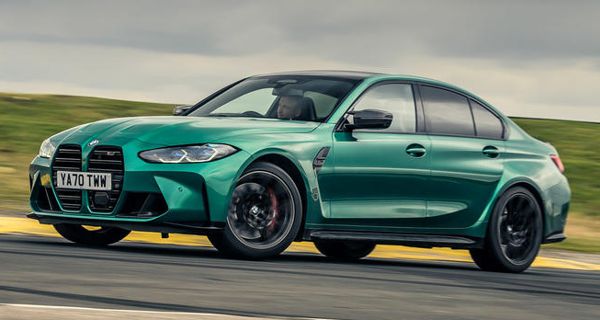
|
|
3
shocking elements of the new M3: price, size and that nose.
|
|
The new M3 shocks the
world in several ways. The first is the full-height double-kidney
grille that made headlines in every review. “Controversial” is probably
a word too subtle, because the automotive world has a common consensus
that it looks plain ugly. Oversized, inelegantly shaped and even
pointless. A considerable portion of the grille is wasted on the bump
beam and number plate, eliminating any advantages in cooling. Against
tradition, the 2 kidneys are separated completely, pronounce and extend
to their own power bulges on the bonnet, almost as flamboyant as
Detroit metal of the 1950s and 60s. Horizontal elements of the grilles
highlight their angular shapes that don’t fit into the otherwise
smoother shape of the nose. More comically, the number plate hangs in
the middle of the kidneys, destroying any visual messages they want to
bring, if any. The new M3 has an unfortunate nose. If you cannot stand
it, you might stick with the regular M340i.
The second thing to shock us is pricing. Over the last 2 decades, the
M3 gets increasingly more expensive, growing from an affordable sports
sedan to something closer to the territory of Porsche 911. Back then,
an E46 M3 cost £42,500 in the UK market. This rose by 19 percent
to £50,600 on the E92, another 15% to £58,000 on the F80,
and now the G80 takes a 30-percent surge to £75,000, just 10
grand less than the entry-level 911 Carrera. Admittedly, this
£75K gets you the Competition model. The standard M3 is not
offered in UK and many other markets. You can buy both in the USA
though. They cost $70,900 and $73,800 respectively, so the difference
is slim.
The third to shock is how big the car has evolved. Although this has
much to do with the regular 3-Series and in general the market trend of
this class, it is still uncomfortable to see the M3 gets 123mm longer
and 26mm wider, actually larger than an E39 M5 ! More alarming, it
gains some 170-185 kg over its predecessor, resulting in 1705 kg for
the standard M3 or 1730 kg for the Competition model. Yet that is not
the heaviest M3. Now you can add the M5’s rear-biased, drift-ready M
xDrive system to the Competition model for the first time together with
another 50 kilos. And that’s before the introducing of Touring body… so
it’s safe to say the heaviest M3 will exceed 1.8 ton before loading.
Don’t call it a compact sports sedan anymore.
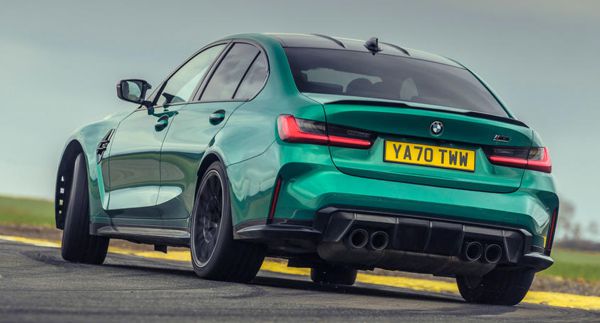
|
|
Quick
though it is, the powertrain is not the highlight of the car.
|
|
The standard M3 and M3 Competition can be priced so closely because
they are the same car except engine ECU mapping and gearbox. We start
with the engine. The new S58 engine is already used on the X3M and X4M
SUVs. Still a 3.0-liter twin-turbo straight-6, but it is slightly
larger (2993 cc instead of 2979 cc thanks to increased stroke),
structurally stronger, higher boosted and has better cooling.
Technologies are broadly the same as before though, including forged
steel crankshaft, closed deck cylinder block, arc-wire spray iron bore
coating, Valvetronics, Bi-Vanos and direct injection, although the
latter has been upgraded to 350 bar. A new two-stage intercooler
improves cooling efficiency and makes possible the increased turbo
boost, which is set at 1.3 bar on the standard car or 1.7 bar on
Competition model. The addition of particulate filters is required to
pass Euro 6d emission test.
As such, the standard model produces 480hp and 406 lbft of torque,
compared with 431hp and the same torque of the old car. The Competition
model lifts these to 510hp and 479 lbft, even higher than the outgoing
M3 CS (460hp and 442 lbft). This is considered necessary to match
arch-rival Mercedes-AMG C63 S and Alfa Romeo Giulia QF, both offer 510
ponies as well. The peak power of both tunes arrives at 6250 rpm, while
the peak torque of the Competition is available between 2750 and 5500
rpm, a band much wider than the outgoing CS model (4000-5380 rpm). On
the downside, the new motor is slightly less keen to rev, as its
redline is lowered from 7600 to 7200 rpm.
While the standard M3 gets a 6-speed manual as standard (carried over
from the old car), the Competition runs a compulsory 8-speed automatic
by ZF. That’s because the manual box cannot withstand its 479 lbft of
torque. Another reason is, the automatic is engineered to be compatible
with M x-Drive, as it is already used on the M5. Keen drivers might
ponder, but like many other cases, the ZF auto offers quicker
acceleration, taking the Competition model only 3.8 seconds to sprint
from rest to 60 mph. The manual-shifted and less powerful M3 takes 4.1
seconds, no match. Both cars have a top speed regulated at 155 mph, but
you can opt for lifting the limit to 180 mph, which is still far below
their potential I would say.
Like last time, the M3 features a carbon-fiber roof as standard to
lower center of gravity a little. It also features pronounced fenders
to accommodate wider tracks and tires. Compared with the lesser
3-Series, its chassis has been reinforced comprehensive around the
engine compartment and the underbody by extra bracings and a new
rigidly-mounted rear subframe. Both suspensions are overhauled with
bespoke wishbones, links and wheel carriers which enable the wider
tracks and increased front camber, while adaptive dampers are retained.
The car is shod with Michelin Pilot Sport 4S tires of 275/40ZR18 up
front and 285/35ZR19 at the rear, but most buyers might opt for
better-looking 275/35ZR19 and 285/30ZR20. Compared with the old car,
its front tires get 20mm wider while the rear only 10mm, so front-end
grip should be much stronger. Braking is provided by 380mm and 370mm
discs front and rear, with 6-pot and single-pot calipers respectively.
Carbon-ceramic brakes is a very expensive option but not strictly
needed.
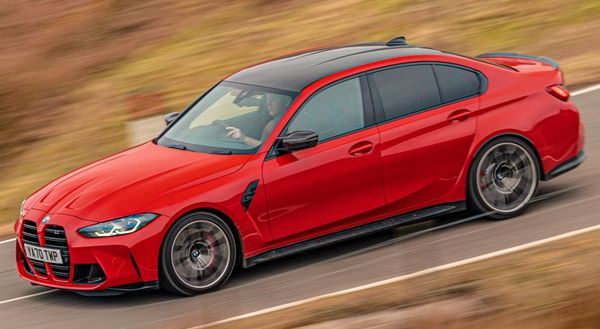
|
|
Lightning
pace and astonishing roadholding on any roads and tracks trump its
rivals.
|
|
On the Road
Step into the cabin, the M3 differs from lesser 3-Series mainly in the
thick-rim steering wheel and heavily bolstered bucket seats. You might
opt for expensive
carbon-fiber buckets, but mind you, they are very tight and therefore
not suitable for big guys or long trips. Otherwise, the cabin is just
as great as the 3er: spacious front and back, fresh design,
high-quality, ergonomically sounded and equipped with the best
infotainment system on the market.
Powertrain used to be the highlight of M3, or just any M cars, but in
turbocharging era this is no longer true. On the M3 Competition, there
is some turbo lag low down, noticeably more than Alfa Giulia QF or AMG
V8, but once spooled up the straight-6 is hugely punchy, flexible and
responsive. While the Alfa chases revs with a sweet linear manner, the
BMW responds to your input like an on-off switch. You need power? You
get it right now. No wait. No efforts required. The 8-speed auto seems
to shift just as quick as the outgoing dual-clutch manual yet with
added smoothness. Downshift may be a tad slower, but the superior
torque is more than enough to compensate. As a result, the M3
Competition offers astonishing straight line speed, stronger than any
of its rivals. Nevertheless, it lacks the sound quality of Alfa V6 and
AMG V8. The bassy, gravelly noise is not particularly musical, even if
artificially enhanced by speakers. Open the windows and you’ll hear a
rather muted exhaust note for a performance car, blame to the
particulate filters. Yes, it is a remarkable powerplant by any
objective measurement, but the emotion and inspiration of the last
naturally aspirated M3s are not here.
Instead of powertrain, what makes this M3 great is chassis. Like any
current generation 3-Series, its suspension is stiff, so stiff that
even Comfort mode is marginal on B-roads. However, the extra control
offered by the stiff setup, in addition to the rock-solid chassis
(thanks to those reinforcement), brings a new level of handling. In
particular, the roadholding is astonishing. It seems to offer endless
front-end grip, biting the road hard and keeping turn-in razor-sharp.
It carries huge speed into and out of corner, yet keeps everything
tightly controlled, precise and stable. On a dry road it is extremely
difficult to overwhelm its grip or unsettle its fine balance. On a
track, when the tail start sliding, the inherent balance and the active
differential keep things tidy, far more benign than the last M3. That’s
why it offers great confidence to attack any roads. If you want to go
from A to B in minimal time, the M3 Competition is the one you will
choose over Alfa or AMG.
With this superior handling, you may forgive less important flaws such
as a not very communicative steering, the hard ride, the lack of full
manual gearshift or even the not so romantic power delivery and sound.
Yes, the Alfa Romeo feels lighter, steers better, rides smoother and
revs sweeter, but the BMW trumps it in speed, body control, roadholding
and the fact that you can push it harder still. The Alfa strikes back
with a shape you will fall in love from first sight, while the BMW wins
your brain with its superior interior and build quality. Which one is
our first choice?
It’s a close call. In the end, the M3 loses by a nose. That nose!
|
Verdict:      |
Published
on 27
Jul 2023
|
All rights reserved.
|
|
M3 CS (G80)
|
|
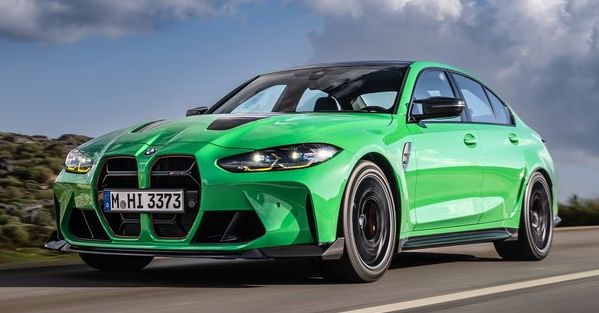
|
|
This
is currently the fastest and most expensive 3-Series model you can
buy...
|
|
Once upon a time, if you
want to buy a fast BMW 3-Series, your choices are few and very
straightforward. If you had not much money, a six-cylinder 323i or 325i
would be the obvious choices. With more money and more desire for
speed, the M division would offer you an M3. That’s all.
Fast forward to today, if a 330i fails to satisfy you, you can opt for
M340i, with or without xDrive. Further up, you can opt for the standard
M3 with 480 hp, or the 510 hp M3 Competition. Again, they can be either
rear-drive or xDrive, plus you have the option of Touring (estate /
wagon) body. If the M3 Competition xDrive’s 0-60 time of 3.4 seconds
and 180 mph top speed still fail to thrill you, or its £80K price
tag fails to raise your eyebrows, BMW will recommend you to consider M3
CS. Mind you, the latest Club Sport model is not exactly a
track-focused machine, as it still rides on Michelin Pilot Sport 4 S
road tires rather than anything with the word “Cup” or “Corsa”, but it
is currently the fastest and most expensive 3-Series model you can buy
from dealerships. It will set you back at an eye-popping
£120,000. Oh, I still remember the E46 M3 charged £42,500
when it was new. The hierarchy of fast 3-Series increasingly looks like
that of the Porsche 911.
Reading through the specifications, modifications from the M3
Competition to M3 CS are not as big as you would expect. That’s not to
say the results were subtle, but it is more a proof that the base car
was engineered so strong that it can accept significant boost of power
without much change in hardware. Take the S58 twin-turbo straight-six
motor for example, its close-deck cylinder block and crankcase and
cooling system were somewhat over-engineered for the Competition model
– and that is partly why that car is so heavy – so BMW just needs to
rewrite the ECU codes, dialing the boost pressure from 1.7 to 2.1 bar
and get an extra 40 horsepower. Torque is still limited to 479 lbft,
which seems to be the torque capacity of its ZF 8-speed automatic
transmission, but it sustains to nearly 6000 rpm, while the motor will
easily spin to 7200 rpm before fuel cut-out. Stiffer engine mounts
aside, there is no change to the powertrain hardware.
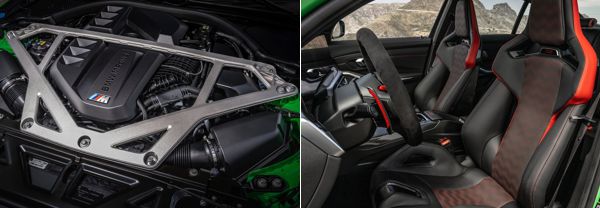
|
|
A
stronger multi-point aluminum tower braces lead to sharper steering.
|
|
Unlike its 2-door sibling M4 CSL, the M3 CS has xDrive fitted standard.
Again this proves that it is less a track car than you might think.
Furthermore, the weight saving measures are limited to the introduction
of CFRP bonnet, aero kits and door mirrors (the roofs of M3 and M3
Competition are already CFRP), and the standard fitment of M carbon
bucket seats, a titanium exhaust silencer (which cuts 4 kg) and lighter
alloy wheels. Overall, the CS is just 15 kg lighter than the
Competition xDrive, therefore it is not a lot faster in straight line.
BMW claims 0-60 mph in 3.3 seconds, or a tenth quicker than the lesser
model, while speed limiter is lifted to 188 mph.
However, open the bonnet you will see a stronger multi-point aluminum
tower braces that reinforce the front suspensions and engine
compartment. This means the CS is not just about more power, but it has
a stronger chassis to match. The springs, dampers, anti-roll bars and
camber setting are all unique to the car, as are the tuning of
variable-ratio power steering and stability control. Ceramic brakes
remains optional but highly recommended, because its reduced unsprung
weight can compensate for the stiffer suspension setup.
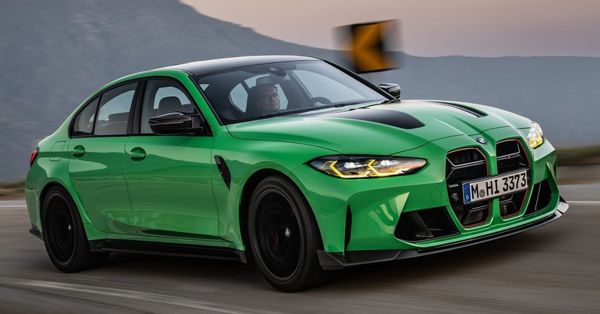
|
|
Its
handling is a step up from the Competition, allowing you to push
harder, corner faster and brake later yet feeling more controllable and
reassuring.
|
|
Sitting in the low and cocooning carbon bucket, you will immediately
realize how driver-focused the CS is. “Hardcore” is not the right word
to describe it, because it rides just as good as the M3 Competition on
normal roads, which is to say firmer than an Alfa Giulia QF but far
from unbearable. With all seats in place, a usable boot, high quality
interior and all those high-tech infotainment gadgets, the CS remains a
fairly good daily driver. Meanwhile, it is also noticeably sportier
than the lesser M3 models. The steering feels sharper and better
connected to the road. The body control gets even tauter. The front-end
grip is incredible, resulting in a pointier nose and free of
understeer. Its handling is a step up from the Competition, allowing
you to push harder, corner faster and brake later yet feeling more
controllable and reassuring. Now with a stiffer chassis and more
incisive control of its mass, the CS can transform its tremendous
traction and grip into significantly quicker lap time. Unquestionably,
it will destroy Alfa Romeo on a race track.
The same goes for the modified powertrain, whose upshift feels crisper
and titanium exhaust screams louder, if still not the most melodic
sound. The CS is better than any other M3s in every respect, except
affordability.
Yes, £120K is ridiculous for a compact sports sedan, especially
if you drive it on roads only. While we applaud the M division for
creating this car, we would be happy to spend hard-earned money on the
less powerful but lighter-feeling and more absorbent Giulia QF,
especially when the Alfa Romeo’s nose looks so much better than the
BMW’s.
|
Verdict:      |
|